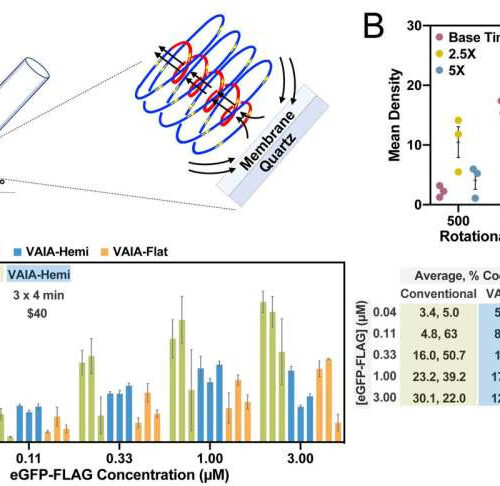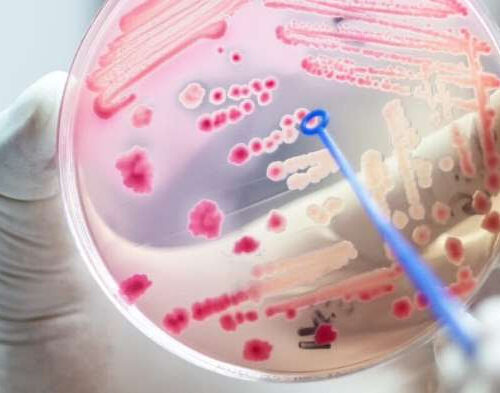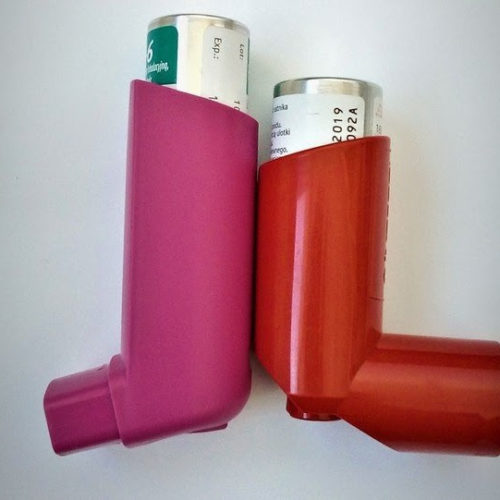by University of California, Los Angeles Credit: Unsplash/CC0 Public Domain A new study has identified potential broad-spectrum antiviral agents that can target multiple families of RNA viruses that continue to pose a significant threat for future pandemics. The study, led by Gustavo Garcia Jr. in the UCLA Department of Molecular and Medical Pharmacology, tested a library...
Tag: <span>Infectious diseases</span>
Big step in rapid diagnostics for infectious diseases
by Flinders University Optimization of the VAIA method. A) Nitrocellulose membranes dotted with target antigens are concentrically placed in a VFD reactor housing a quartz tube (20 mm OD, 17.5 mm ID, 18.5 cm in length). The VFD reactor tube is tilted at 45° and rotated at 1500 rpm throughout the assay steps. At this speed the shear stress is...
‘Host-directed therapy’ could treat infectious diseases—including COVID—and limit drug-resistance
by Christian Doerig, Genia Burchall, Jack Adderley and Tayla Williamson, The Conversation Credit: Shutterstock Antibiotics, together with antivirals and anti-parasitic drugs, can save the lives of people who’ve contracted an infectious disease. But the rise of drug-resistance means new strategies are needed. At the end of last year, the World Health Organization declared antimicrobial resistance one of...
Development of a tool for monitoring infectious diseases
The Software Engineering Lab (SEL) research group at Universidad Carlos III de Madrid (UC3M) has been involved in the development of a tool for monitoring infectious diseases, along with the companies Dantia Tecnología, Viamática and the University of Murcia. The project was funded by the Spanish Ministry of Finance, Industry and Competitiveness and the Centre for the...
Prevalence of lung condition more than double WHO figures, find students
Around 550 million people have the chronic obstructive pulmonary disease (COPD), according to two University of Manchester medical students. The figure more than doubles the previous estimate of 251 million people with the illness linked to smoking by the World Health Organization (WHO) Global Burden of Disease Study. The University of Manchester students, Emily Hammond...
International recommendations for nontuberculous mycobacteria
GERMAN CENTER FOR INFECTION RESEARCH NTMs are closely related to tuberculosis bacteria and can (but do not need to) cause infectious diseases in humans. They are called “nontuberculous mycobacteria” (NTMs) to distinguish them from tuberculosis bacteria. There are approximately 200 different species and subspecies of these bacteria. Patients with bronchiectasis (dilation of the airways) are...
Adults with obesity more likely to develop H1N1 influenza
by Nardy Baeza Bickel, University of Michigan Adults with obesity are more susceptible to influenza A/H1N1pdm—the swine flu virus, according to a new study that did not, however, find a similar association with the seasonal flu. The results could be relevant in understanding the mechanisms by which infectious diseases such as influenza or the ongoing...
Researchers: COVID-19 spreads ten meters or more by breathing
by Queensland University of Technology A plea issued by 239 scientists from around the world to recognize and mitigate airborne transmission of COVID-19 addressed to international health authorities is to be published in the journal Clinical Infectious Diseases. The 239 signatories from 32 countries come from many different areas of science and engineering, including virology,...
Infectious diseases: When a kiss is more than a kiss
Often referred to as the “kissing disease,” mononucleosis is a common ailment caused by the Epstein-Barr virus that is transmitted through saliva. Credit: CC0 Public Domain While you can get the virus through kissing, you also can be exposed through a cough or sneeze, or by sharing cups or utensils with someone who is infected....
Glow-in-the-dark paper as a rapid test for infectious diseases
Researchers from Eindhoven University of Technology (The Netherlands) and Keio University (Japan) present a practical and reliable way to test for infectious diseases. All you need are a special glowing paper strip, a drop of blood and a digital camera, as they write in the scientific journal Angewandte Chemie. Not only does this make the technology...
- 1
- 2







